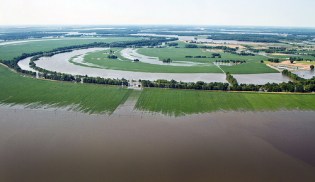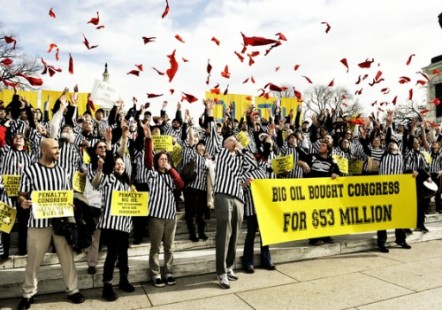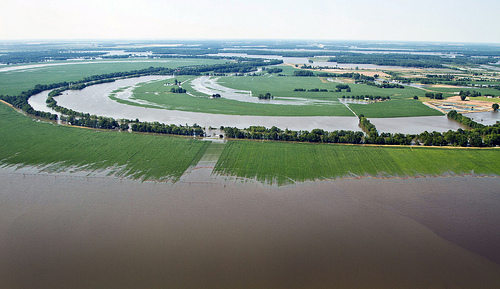
Last year's flooding on the Mississippi River has been linked to climate change. (Photo by the USDA.)
While the topic of climate change in this country often feels like the truth that dare not speak its name, there is no escaping what Grist’s own David Roberts refers to as its “brutal logic.” The planet will warm no matter how international climate negotiations — the latest round having just occurred in Durban, South Africa — play out.
It’s because of that inevitable warming that Britain’s chief scientist, John Beddington, along with an international group of scientists, have taken to the pages of Science magazine this month to ask climate negotiators to stop ignoring agriculture.
Agriculture has been hovering just on the margins of climate change policy. Of course, that’s no coincidence. Precise measurement of the climate impact of many industrial farming practices remains difficult and controversial, and the U.S. in particular has resisted any attempts to formalize the agricultural sector’s obligation to climate mitigation.
The reasons for this are twofold: Big and Ag. After all, it was American agribusiness that exacted virtual exemption from the Obama administration’s failed attempt at a climate bill as a price for its potential support. The EPA continues to develop its carbon emissions tracking plan, but the agricultural sector has managed to keep itself out of that, too.
Of course, all the lobbying in the world won’t exempt actual farming from the effects of climate change. For example, there is strong science linking the massive Midwestern floods last spring and summer to the changing climate — the idea being that as temperatures rise, the atmosphere is able to hold more moisture, which it then dumps as increasingly larger amounts of rain.
And now a new report from the Environmental Defense Fund and Duke University suggests another pernicious climate effect on agriculture, in this case in California. As the western climate warms, the state’s prodigious grasslands will shrink. And with them, so will the herds of grass-fed cattle.
The study’s authors predict one of two different climate change scenarios for California: a warm-wet scenario for the region in which grasslands will be replaced with shrublands, or an arid scenario which will cause desertification on current pastureland. In either case, the result is less grass. And, it should be pointed out, less grass-fed beef.
Meanwhile Big Ag’s answer to the challenges agriculture faces remains more of the same. In the Midwest that means turning to techniques such as “tile drainage.” This practice involves burying drainage pipes under fields to keep the ground from getting too saturated after increased rainfall.
But as scientists Mark David and Eric Davidson explain, tile drainage use in the Midwest increases synthetic nitrogen fertilizer runoff into the Mississippi River and ultimately into the Gulf of Mexico. And some of this excess nitrogen fertilizer — exactly how much is unknown — ends up in the atmosphere as nitrous oxide, a greenhouse gas 300 times more potent than carbon dioxide.
And yet climate treaties give agriculture a pass.
Meanwhile, an alternative vision for how Midwestern farmers might adapt to a changing climate comes via this op-ed in a local Iowa paper on the subject of protecting Iowa cities from the new threat of repeated massive flooding. These scientists observe that:
Historically, Iowa was covered by deep-rooted forests, prairies, savannahs and wetlands. This flora/hydrological system created a vast sponge ranging some 15 to 30 feet in depth both below and above the surface. This sponge allowed rainwater to infiltrate at 7 to 14 inches per hour, while purifying and slowly releasing the stored water for plant uptake and recharging groundwater and aquifers.
But over time Iowa’s native landscape was plowed under and replaced with row-cropped monoculture (i.e corn, corn, corn). The natural sponge became a sluice — and when it rains, water now pours into river systems at rates far beyond their capacity to absorb it. However, there is another way. The op-ed reads:
… [O]ther innovative, alternative agricultural systems — available now — would allow us to re-perennialize agriculture and rebuild the topsoil “sponge,” with its flood-mitigating capabilities. An Iowa State University study has shown that interspersing annual crop fields with strips of native prairie, which can soak up 7 to 13 inches of rain per hour, can eliminate up to 95 percent of erosion.
They also advocate for getting livestock out of confinement sheds and feedlots and back on grass — which, when paired with rotational grazing practices, would increase the land’s ability to absorb rainfall even more.
Yet these kind of solutions remain almost entirely outside the mainstream debate.
Instead, industrial agriculture will likely maintain its focus on productivity above all and Midwestern cities will likely invest billions of dollars in flood protection. It will be expensive and, as many cities have found out over the last decade, comes with no guarantee of success.
Meanwhile, most scientists, journalists, and government officials utterly buy into the industry-created dichotomy between agricultural productivity and environmental and climate protection — unless they’re hyping genetically engineered “drought tolerant” seeds, of course.*
This appears to be the case in large part because many of the most environmentally sustainable, climate-friendly practices, like those outlined in the U.N.’s Food and Agriculture Organization’s Save and Grow initiative, are not primarily market-based. If a technique doesn’t offer a profit opportunity for one or more corporations, it’s the proverbial tree falling in the woods with no one to hear it.
It may sound like an overly simplistic, even conspiratorial, take on the situation, and I’d welcome evidence to the contrary. But the fact is, it doesn’t take much effort to find promising solutions to agriculture’s climate obligations. Those solutions are just unlikely to create new corporate winners. The only winners in the move to climate-friendly ag would be farmers, eaters, rivers, oceans, the wildlife … oh yeah, and the climate of the entire planet. But where’s the profit in that?
* Speaking of which, it’s worth nothing that even the USDA admits that Monsanto’s recently approved genetically engineered drought-tolerant corn is actually no more drought-tolerant than conventional hybrids that are already available.



